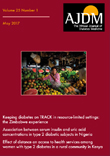A Brief Study on Vasopressin and how it affects the Diabetes
*Corresponding Author:
Received: 28-Jun-2022, Manuscript No. ajdm-22-73003; Accepted Date: Jul 22, 2022 ; Editor assigned: 30-Jun-2022, Pre QC No. ajdm-22-73003 (PQ); Reviewed: 14-Jul-2022, QC No. ajdm-22-73003; Revised: 19-Jul-2022, Manuscript No. ajdm-22-73003 (R); Published: 26-Jul-2022
INTRODUCTION
Human vasopressin, likewise called antidiuretic chemical (ADH), arginine vasopressin (AVP), or argipressin, is a chemical blended from the AVP quality as a peptide prohormone in hypothalamic neurons and changed over completely to AVP. It then, at that point, goes down an axon that ends in the back curve of the pituitary organ and is let out of vesicles into the course in light of extracellular liquid hypertonicity. AVP has two principal capabilities. To begin with, it expands how much sans solute water reabsorbed once more into the dissemination from the filtrate in the renal tubules of the nephrons. Second, AVP contracts arterioles, which increments fringe vascular opposition and raises pulse.
Description
Arginine vasopressin and oxytocin are combined in the cores of the nerve center, and every chemical is gotten from individual neurons. The principal locales are the paraventricular and supraoptic cores, albeit different cores, may likewise be involved. Each non-apeptide is combined with a particular intraneuronal transporter protein called neurophysin which thus is gotten from the forerunner particle. AVP and its particular neurophysin move from the neuron body in the nerve center along axons as individual neurosecretory granules at a pace of 1-3 mm/hour to three different cerebrum districts. The principal plot ends in the back curve of the pituitary organ, and the other two stocks the center greatness and floor of the third ventricle.
Vasopressin or antidiuretic chemical (ADH) or arginine vasopressin (AVP) is a nonapeptide blended in the nerve center. Science realizes that it assumes a significant part in controlling the body’s osmotic equilibrium, circulatory strain guideline, sodium homeostasis, and kidney capability. Given its significant job in many capabilities, it is business as usual that ADH is of extraordinary clinical significance. ADH basically influences the capacity of the kidneys to reabsorb water; when present, ADH actuates the statement of water-shipping proteins in the late distal tubules and gathering conduits to increment water reabsorption. A few illnesses happen when the body lets completely go over the discharge of ADH or responds to its presence.
Arginine-vasopressin enactment is one of the hormonal reactions to vasodilation-related hypotension. Let out of the post-pituitary organ, vasopressin causes vasoconstriction by actuating V1a receptors situated on vascular smooth muscle cells. Due to its non-selective fondness for arginine receptors, vasopressin additionally actuates V2 (situated on renal cylindrical cells) and V1b (situated in the front pituitary and pancreas) receptors, in this manner possibly adding to undesirable aftereffects like impeded diuresis. , procoagulant properties due to von Willebrand factor delivery and platelet enactment.1-4
Conclusion
The AVP quality gives directions to making a chemical called vasopressin or antidiuretic chemical (ADH). ADH begins as a bigger particle called a preprohormone, which is cut (cut) and changed to create the dynamic chemical and a few related proteins. The preprohormone is made in a locale of the cerebrum called the nerve center. It is then shipped to the close by pituitary organ, where dynamic ADH is put away until it is required. The significant capability of ADH is to assist with controlling the body’s water balance by deciding how much water is discharged in pee. Regularly, when an individual’s liquid admission is low or when a ton of liquid is lost the pituitary organ delivers more ADH into the circulatory system. Elevated degrees of this chemical direct the kidneys to reabsorb more water and to make less pee. At the point when liquid admission is satisfactory, the pituitary organ delivers less ADH. Lower levels of this chemical reason the kidneys to reabsorb less water and to make more urine.
References
- Acher R, Chauvet J. The Neurohypophysial endocrine regulatory cascade: precursors, mediators, receptors, and effectors. Front in Neuroendocrinol. 1995; 16(3): 237-289.
[Crossref] [Google Scholar] [PubMed]
- Sukhov RR, Walker LC, Rance NE, et al. Vasopressin and oxytocin gene expression in the human hypothalamus. J Comparative Neuro. 1993; 337 (2): 295-306.
[Crossref] [Google Scholar] [PubMed]
- Pillai BP, Unnikrishnan AG, Pavithran PV. Syndrome of inappropriate antidiuretic hormone secretion: Revisiting a classical endocrine disorder. Indian J Endocrinol Metab. 2011; 15 (Suppl 3): S208-S215.
[Crossref] [Google Scholar] [PubMed]
- Babar SM. SIADH associated with ciprofloxacin. Ann Pharmacother. 2013; 47(10): 1359-1363.
[Crossref] [Google Scholar] [PubMed]





